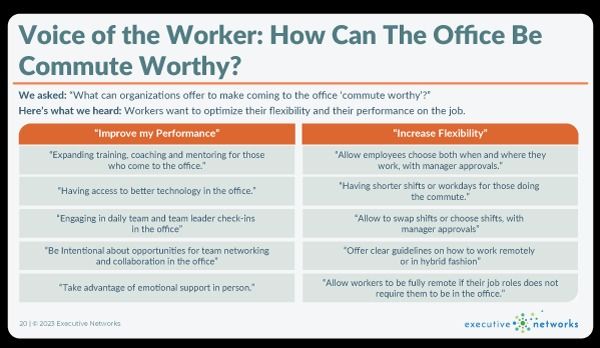It may be unintentional, but proximity bias is a growing reality in the hybrid workplace — and HR leaders want to be sure it doesn’t happen.
It’s a crisis of visibility: People in powerful, decision-making positions tend to treat employees who are physically closer to them more favorably than those who aren’t.
And most of us already recognize the bias exists: More than 70% of senior HR leaders and 62% of senior business leaders agree there’s a proximity bias toward the in-person workforce over the remote and hybrid teams, according to Executive Network’s 2023 Future of Working and Learning Report.
Some of it comes from antiquated thinking (which is just pre-pandemic thinking) that people in the office do more and perform better than those working from home. Productivity research has proven that wrong. Some of it is plain, old cliché-esque: Out of sight, out of mind — when a special project or recognition comes up. Or Love the one you’re with — because they’re an easy reach.
Examples of proximity bias
“Essentially proximity bias is exhibited in presenteeism, where managers value the contributions of employees they see every day over the contributions of remote or hybrid employees who are not in the office on a regular basis,” says Jeanne Meister, Executive VP of Executive Networks.
Some examples are:
- Excluding remote or hybrid employees from important meetings
- Excluding them from opportunities to take on stretch assignments or mentoring
- Evaluating on-site employees’ performance more favorably than remote or hybrid employees, and
- Promoting on-site employees sooner than remote or hybrid employees.
“HR leaders need to take proximity bias seriously and acknowledge this is happening in the workplace where work happens outside of a nine-to-five day and often outside of an office,” says Meister.
Here are six ways to mitigate proximity bias.
Make it impossible
The ideal fix to proximity bias: Make it impossible.
How? Either go with all remote or all on-site work arrangements. That’s what one expert suggests. It’s the only way to fully level the playing field.
By now, though many companies are beyond making that choice. So we have more tips here on how to avoid proximity bias.
Acknowledge the possibility
We don’t know what we don’t know. So help front-line managers avoid it by understandingthat it happens.
“Acknowledge the tendency for proximity bias is real and a natural human behavior,” says Meister. “And adjust for it by making a conscious effort to value the contributions of remote and hybrid employees who meet deliverables. Being aware of proximity is the first step to acting in a more inclusive and intentional way toward all employees, regardless of where they work.”
Change the culture
Once you admit that the bias is possible and anyone can commit it, Harvard Business School experts suggest it’s time to change the culture with this mantra: Excellence from anywhere.
It’s OK — actually, it’s right — to expect employees to perform with excellence, no matter where they work. From there, change goals to valuing deliverables, collaboration and innovation. The more you do this, the more likely the attitude toward excellence anywhere will evolve.
“Create a culture where front-line managers evaluate their team members on their outcomes instead of the number of days they spend in the office,” says Meister.
Simply put, focus on output, not on input or where the input happens.
Set goal policies
If you continue with a hybrid work approach, you’ll want to set clear policies regarding goals — what they are for each role, how you measure achievement and how achievement is rewarded.
Even better, give managers tools to have critical conversations with hybrid or remote employees on how they think they can achieve goals, if they need to adopt new ways of working and the resources they’ll need.
Most critical, reward hybrid and remote work achievements exactly how you laid out in the policies.
The Harvard researchers suggest managers increase feedback sessions or one-on-one meetings with remote direct reports to weekly or bi-weekly. A suggested framework:
- Agree on about five bi-weekly performance goals. Vary them to include short-term, tactical goals and longer-term job improvement goals.
- A few days before the check-in, ask employees to do a brief report on their progress, challenges they face, how they might overcome them, and a few proposed goals for the following week.
- A day before the meeting, give your feedback on your impression of the report and a proposed agenda for the meeting.
- When you meet, coach the employee on how to solve challenges, revise goals that need to be adjusted and affirm their work.
Even better, Meister suggests: “Be intentional about meeting remote or hybrid workers on a regular basis either in a satellite office near their home, for lunch or for networking, stressing the importance of knowing employees outside of a Zoom or Teams call.”
Make the office worthwhile
When possible, get remote and hybrid employees more interested in the office.
“Be clear about what going to the office is still important for and communicate this,” says Meister. “For example, going to the office is often a richer experience when you are engaged in one-on-ones with your manager, collaborating with team members, social networking participation, contributing to product launches and engaging in design thinking sessions. The common thread here is that social connection is worth the commute for employees.”
In fact, when Executive Network researchers asked employees what made the office “commute worthy,” most responses revolved around a tangible reason to get in there.



